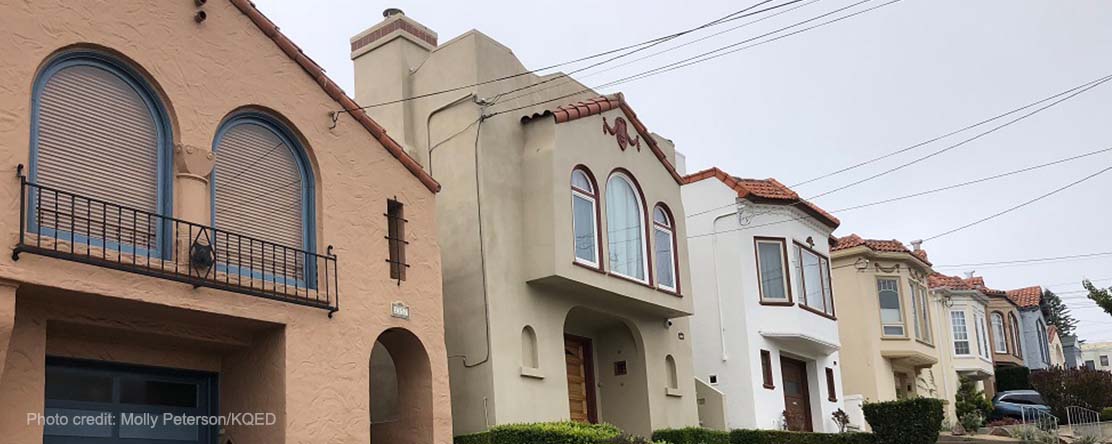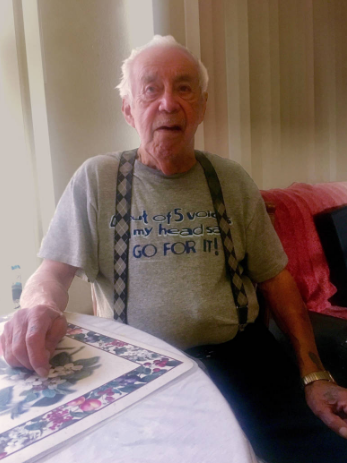
In the News
Investigation Finds Home Can Be the Most Dangerous Place in a Heat Wave
-
Focus Areas
Environmental Health -
Issues
Climate Change -
Programs
Center for Climate Change and Health

Floyd Ware has survived a widow-maker heart attack, layoffs in the tech industry and living a few doors down from the Grateful Dead. But now he worries that heat—in San Francisco, of all places—is going to kill him.
“I don’t want to exaggerate, but at times it seems all-encompassing, you can’t get away from it,” he says.
Ware, 67, is a wiry man and, for the record, he doesn’t exaggerate. Even during a foggy August, his room at Bayanihan House, south of Market Street, is consistently hotter than outside. When it was 63 degrees at San Francisco’s weather station, it was 81 degrees in his spotless, small space.
Last Labor Day, San Francisco’s record-high temperatures drove him and other residents out onto the street and into the basement of Ware’s single room occupancy building, where large fans blow hot air around rather than cool it. Only leaving his room prevents him from falling seriously ill, he says.
This summer, we put small heat sensors in 31 homes in four counties: Contra Costa, Santa Clara, San Francisco, and Los Angeles. The homes had no air conditioning, and the sensors took temperature readings for three weeks in July, August, or September. In every home, heat was stubborn. It stuck around even as the sun dropped.
 |
And at night, when people’s bodies need to be able to cool off, all the homes we measured let go of heat slowly, staying hotter inside than it was outside – as much as 15 or 20 degrees hotter.
Heat is one of the top public health threats from climate change, according to the state of California. The illnesses and deaths that result from it are preventable. But where people spend the majority of their time, at home, no right to cooling is guaranteed. Public officials around the Bay Area are still figuring out how to warn people and how to respond to heat—both as an extreme event, and as an emerging health threat.
Until they do, a divide is deepening between the cool haves and the hot have-nots.
It’s About Where You Live
Housing is a huge expense that influences people’s health. In a heat wave, the most dangerous places can be inside of homes and apartments.
In San Francisco, health officials have concluded that heat builds up significantly in some glassy high-rises and many older residential hotels. Our sensor measurements found that the single room occupancy buildings that once served gold prospectors and seamen stood out as consistently hotter than the weather outside.
Inside these buildings, climate-driven heat already threatens the health and finances of people most vulnerable to it: people like Floyd Ware. After three years in his one-room rental, Ware says his health has gotten worse. He keeps a plastic tub full of medications for his chronic lung disease on a shelf.
“The thing with emphysema is, you can’t get the air out. If you can’t get the air all the way out, you can’t get the air in,” Ware says. “And the problem with the heat is, it restricts the lungs. So it has an appreciable effect.”
Ware’s doctors advised him not to wait when a sudden emphysema attack comes. Three times in two years, he’s placed an emergency call for an ambulance to Zuckerberg San Francisco General Hospital.
Medicare pays most of it, but each time, Ware owes out-of-pocket costs. His social security income pays for his stay in the residential hotel; what’s left over pays for his food and medicine. As a result, Ware says, he has racked up $2,000 in debt.
“I don’t know how I’m going to pay ‘em,” he says.
There Is No Legal Right to Cooling
In-home cooling can reduce the risk of heat illness, according to Linda Rudolph, an expert on health and climate change with the Oakland-based Public Health Institute (PHI). But just one out of every ten Bay Area homes has central air conditioning. Tenants we talked to said they either couldn’t afford to buy a portable AC or couldn’t afford to turn it on.
“Poor people are less likely to have air conditioning,” Rudolph says. “Or they may not have the money to get their air conditioner fixed, or they may live in a rental apartment where the landlord doesn’t want to get it fixed.”
 |
Or it may be that window units only do so much.
At 5:30 p.m. one August evening, it’s still over 90 degrees in Mario Rodriguez’s San Jose apartment—the first floor of a complex with few trees and a scrabbly lawn, along busy North Main street.
Rodriguez has low blood pressure and is on constant oxygen, for lung trouble.
“When it gets hot I get kind of dizzy,” he says. “I get tired and I have to sit down for a few minutes. Or I start sweating and then I start fainting out.”
Rodriguez bought a window air conditioner from a friend for $75, even though he knew it would raise his electric bill. The unit cost him an additional $75 when his rental manager required him to install it with plexiglass around it, rather than plywood.
He added the air conditioner during the period when we were measuring heat in his apartment. But even on days when he ran the it, indoor temperatures peaked at 10 degrees hotter than outdoors.
Habitability, under federal and California law, requires only that water run freely, and that heating be available. New York and some Canadian cities have considered making in-home cooling a right. But in Sacramento, the idea of a tenant’s right to cooling has died a quick death.
Cyndy Comerford used to work for the San Francisco Department of Public Health, where she analyzed housing and heat. Now, she directs climate programs for the city of San Jose.
“I really do think that government potentially has a role in making sure buildings are safe,” Comerford says. “We do that structurally. We make sure they’re not too cold. We ought to make sure they’re not too hot, too.”
And keeping buildings cool isn’t only about air conditioning, as researchers and urban designers have concluded.
Originally published by KQED
More Updates
Work With Us
You change the world. We do the rest. Explore fiscal sponsorship at PHI.
Support Us
Together, we can accelerate our response to public health’s most critical issues.
Find Employment
Begin your career at the Public Health Institute.



